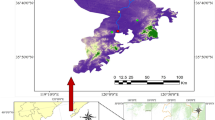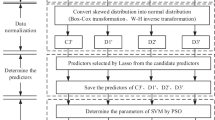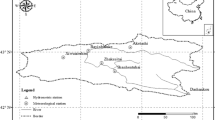Abstract
Accurate runoff modeling has an important role in water resource management. Attributable to the effects of climate variability and vegetation dynamics, runoff time series is nonstationary, resulting in the difficulty of runoff modeling. Detecting the temporal features of runoff and its potential influencing factors can help to increase the modeling accuracy. Selecting the Yihe watershed in the rocky mountainous area of northern China as a case study, multivariate empirical mode decomposition (MEMD) was adopted to analyze the time scales of the monthly runoff and its influencing factors, i.e., precipitation (P), normalized difference vegetation index (NDVI), temperature (T), relative humidity (RH), and potential evapotranspiration (PE). Using the MEMD technique, the original monthly runoff and its influencing factors were decomposed into six orthogonal and bandlimited functions, i.e., intrinsic mode functions (IMF1-6) and one residue, respectively. Each IMF is a counterpart of the simple harmonic function and represents a simple but general oscillatory mode in the original time series data. The results of the IMF contribution rate showed that the annual cycle had the most important role in runoff, P, NDVI, T and PE change. The contribution of quarterly oscillation was the largest contribution for the month RH variability. The monotonic residue showed that the predominant trends of runoff, P, NDVI, T, RH, and PE were decreasing from 2006 to 2015. Stepwise multiple linear regression (SMLR) was chosen to simulate the runoff IMFs and residue. The modeling results using the IMFs and residue of the potential influencing factors as input variables (R2 ranges from 0.53 to 1.0) were better than those using the original time series of influencing factors as input variables (R2 ranges from 0.17 to 0.6). By summing all the modeled IMFs and residues, the monthly runoff model was obtained, which increased the R2 value by 24.2% compared with the SMLR model using the original time series of influencing factors as input. The results indicated that MEMD was efficient for improving the accuracy of nonstationary runoff modeling.




Similar content being viewed by others
References
Adamowski J (2008) Development of a short-term river flood forecasting method for snowmelt driven floods based on wavelet and cross-wavelet analysis. J Hydrol 353:247–266
Bai L, Chen Z, Xu J, Li W (2016) Multi-scale response of runoff to climate fluctuation in the headwater region of Kaidu River in Xinjiang of China. Theor Appl Climatol 125:703–712
Chen X, Huang J, Han Z, Gao H, Liu M, Li Z, Liu X, Li Q, Qi H, Huang Y (2020) The importance of short lag-time in the runoff forecasting model based on long short-term memory. J Hydrol 589:125359
Chou CM, Wang RY (2004) Application of wavelet-based multi-model Kalman filters to real-time flood forecasting. Hydrol Process 18:987–1008
Cohen S, Kettner AJ, Syvitski JPM (2014) Global suspended sediment and water discharge dynamics between 1960 and 2010: continental trends and intra-basin sensitivity. Glob Planet Chang 115:44–58
Cunderlik JM, Burn DH (2003) Non-stationary pooled flood frequency analysis. J Hydrol 276:210–223
Feng ZK, Niu WK, Tang ZY, Jiang ZQ, Xu Y, Liu Y, Zhang HR (2020) Monthly runoff time series prediction by variational mode decomposition and support vector machine based on quantum-behaved particle swarm optimization. J Hydrol 583:124627
Fiener P, Auerswald K, Van Oost K (2011) Spatio-temporal patterns in land use and management affecting surface runoff response of agricultural catchments-a review. Earth-Sci Rev 106:92–104
Gao G, Ma Y, Fu B (2016) Multi-temporal scale changes of streamflow and sediment load in a loess hilly watershed of China. Hydrol Process 30:365–382
Gao S, Huang Y, Zhang S, Han J, Wang G, Zhang M, Lin Q (2020) Short-term runoff prediction with GRU and LSTM networks without requiring time step optimization during sample generation. J Hydrol 589:125188
Gardner LR (2009) Assessing the effect of climate change on mean annual runoff. J Hydrol 379:351–359
Gerten D, Rost S, von Bloh W, Lucht W (2008) Causes of change in 20th century global river discharge. Geophys Res Lett 35. https://doi.org/10.1029/2008GL035258
Hu W, Biswas A, Si BC (2014) Application of multivariate empirical mode decomposition for revealing scale-and season-specific time stability of soil water storage. Catena. 113:377–385
Hu W, Si BC (2013) Soil water prediction based on its scale-specific control using multivariate empirical mode decomposition. Geoderma 193–194:180–188
Huang G, Su Y, Kareem A, Liao H (2016) Time-frequency analysis of nonstationary process based on multivariate empirical mode decomposition. J Eng Mech 142:04015065. https://doi.org/10.1061/(ASCE)EM.1943-7889.0000975
Huang NE, Shen Z, Long SR, Wu MC, Shih HH, Zheng Q, Yen NC, Tung CC, Liu HH (1971) The empirical mode decomposition and the Hilbert spectrum for nonlinear and non-stationary time series analysis. P Roy Soc A-Math Phy 454:903–995
Huang NE, Wu ML, Long SR, Shen SSP, Qu WD, Gloersen P, Fan, KL (2003) A confidence limit for the empirical mode decomposition and Hilbert spectral analysis. Proc R Soc Lond A 459:2317–2345
Huang NE, Wu Z (2008) A review on Hilbert-Huang transform: method and its applications to geophysical studies. Rev Geophys 46:1–23
Huang SZ, Chang JX, Huang Q, Chen YT (2014) Monthly streamflow prediction using modified EMD-based support vector machine. J Hydrol 511:764–775
Huang X, Fang NF, Shi ZH, Zhu TX, Wang L (2019) Decoupling the effects of vegetation dynamics and climate variability on watershed hydrological characteristics on a monthly scale from subtropical China. Agric Ecosyst Environ 279:14–24
Li Z, Xu X, Zhu J, Xu C, Wang K (2020a) Scale-specific controls of sediment yield in karst watersheds. J Hydrol 583:124301–124301
Li B, Shi X, Lian L, Chen Y, Chen Z, Sun X (2020b) Quantifying the effects of climate variability, direct and indirect land use change, and human activities on runoff. J Hydrol 584:124684
Li Z, Fang H (2016) Impacts of climate change on water erosion: a review. Earth-Sci Rev 163:94–117
Liu H, Xu X, Lin Z, Zhang M, Mi Y, Huang C, Yang H (2016) Climatic and human impacts on quasi-periodic and abrupt changes of sedimentation rate at multiple time scales in Lake Taihu, China. J Hydrol 543:739–748
Liu QJ, Zhang HY, Gao KT, Xu B, Wu JZ, Fang NF (2019) Time-frequency analysis and simulation of the watershed suspended sediment concentration based on the Hilbert-Huang transform (HHT) and artificial neural network (ANN) methods: a case study in the Loess Plateau of China. Catena. 179:107–118
Luo Y, Li QL, Yang K, Xie WQ, Zhou XL, Shang CX, Xu YT, Zhang Y, Zhang C (2019) Thermodynamic analysis of air-ground and water-ground energy exchange process in urban space at micro scale. Sci Total Environ 694:133612. https://doi.org/10.1016/j.scitotenv.2019.133612
Lyn DA (1987) Unsteady sediment-transport modeling. J Hydraul Eng 113:1–15
Massei N, Fournier M (2012) Assessing the expression of large-scale climatic fluctuations in the hydrological variability of daily Seine river flow (France) between 1950 and 2008 using Hilbert–Huang Transform. J Hydrol 448-449:119–128
Napolitano G, Serinaldi F, See L (2011) Impact of EMD decomposition and random initialisation of weights in ANN hindcasting of daily stream flow series: an empirical examination. J Hydrol 406(3-4):199–214
Nourani V, Baghanam AH, Adamowski J, Gebremichael M (2013) Using self-organizing maps and wavelet transforms for space-time pre-processing of satellite precipitation and runoff data in neural network based rainfall-runoff modeling. J Hydrol 476:228–243
Pruski FF, Nearing MA (2002) Runoff and soil-loss responses to changes in precipitation: a computer simulation study. J Soil Water Conserv 57(1):7–16
Ran L, Lu X, Xu J (2013) Effects of vegetation restoration on soil conservation and sediment loads in china: a critical review. Crit Rev Environ Sci Technol 43:1384–1415
Rehman N, Mandic DP (2010) Multivariate empirical mode decomposition. Proc R Soc Lond A 466:1291–1302
Rezaie-Balf M, Kim S, Fallah H, Alaghmand S (2019) Daily river flow forecasting using ensemble empirical mode decomposition based heuristic regression models: application on the perennial rivers in Iran and South Korea. J Hydrol 572:470–485
Sang YF, Wang Z, Liu C (2014) Comparison of the MK test and EMD method for trend identification in hydrological time series. J Hydrol 510:293–298
Shen C (2018) A transdisciplinary review of deep learning research and its relevance for water resources scientists. Water Resour Res 54:8558–8593
Shen Q, Cong Z, Lei H (2017) Evaluating the impact of climate and underlying surface change on runoff within the Budyko framework: a study across 224 catchments in China. J Hydrol 554:251–262
Shi Z, Ai L, Li X, Huang X, Wu G, Liao W (2013a) Partial least-squares regression for linking land-cover patterns to soil erosion and sediment yield in watersheds. J Hydrol 498:165–176
Shi C, Zhou Y, Fan X, Shao W (2013b) A study on the annual runoff change and its relationship with water and soil conservation practices and climate change in the middle Yellow River basin. Catena. 100:31–41
Song JH, Her Y, Park J, Kang MS (2019) Exploring parsimonious daily rainfall-runoff model structure using the hyperbolic tangent function and Tank model. J Hydrol 574:574–587
Stockwell RG (2007) A basis for efficient representation of the S-transform. Digit Signal Process 17:371–393
Tan QF, Lei XH, Wang X, Wang H, Wen X, Ji Y, Kang AQ (2018) An adaptive middle and long-term runoff forecast model using EEMD-ANN hybrid approach. J Hydrol 567:767–780
Taormina R, Chau KW, Sivakumar B (2015) Neural network river forecasting through baseflow separation and binary-coded swarm optimization. J Hydrol 529:1788–1797
Tiwari MK, Chatterjee C (2010) Development of an accurate and reliable hourly flood forecasting model using wavelet-bootstrap-ANN (WBANN) hybrid approach. J Hydrol 394:458–470
Tuset J, Vericat D, Batalla RJ (2016) Rainfall, runoff and sediment transport in a Mediterranean mountainous catchment. Sci Total Environ 540:114–132
Unnikrishnan P, Jothiprakash V (2018) Daily rainfall forecasting for one year in a single run using singular spectrum analysis. J Hydrol 561:609–621
Vercruysse K, Grabowski RC, Rickson RJ (2017) Suspended sediment transport dynamics in rivers: multi-scale drivers of temporal variation. Earth-Sci Rev 166:38–52
Wang T, Zhang M, Yu Q, Zhang H (2012) Comparing the applications of EMD and EEMD on time-frequency analysis of seismic signal. J Appl Geophys 83:29–34
Wang WC, Chau KW, Cheng CT, Qiu L (2009) A comparison of performance of several artificial intelligence methods for forecasting monthly discharge time series. J Hydrol 374:294–306
Wang WC, Chau KW, Qiu L, Chen YB (2015) Improving forecasting accuracy of medium and long-term runoff using artificial neural network based on EEMD decomposition. Environ Res 139:46–54
Wei Q, Liu Q, Fan SZ, Lu CW, Lin TY, Abbod MF, Shieh JS (2013) Analysis of EEG via multivariate empirical mode decomposition for depth of anesthesia based on sample entropy. Entropy. 15:3458–3470
Wei W, Chen L, Fu B, Huang Z, Wu D, Gui L (2007) The effect of land uses and rainfall regimes on runoff and soil erosion in the semi-arid loess hilly area, China. J Hydrol 335:247–258
Wei Y, Jiao J, Zhao G, Zhao H, He Z, Mu X (2016) Spatial-temporal variation and periodic change in streamflow and suspended sediment discharge along the mainstream of the Yellow River during 1950-2013. Catena. 140:105–115
Wu CL, Chau K, Li YS (2009) Predicting monthly streamflow using data-driven models coupled with data-preprocessing techniques. Water Resour Res 45:W08432. https://doi.org/10.1029/2007WR006737
Xiang Z, Yan J, Demir I (2020) A rainfall-runoff model with LSTM-based sequence-to-sequence learning. Water Resour Res 56. https://doi.org/10.1029/2019WR025326
Xie T, Zhang G, Hou J, Xie J, Lv M, Liu F (2019) Hybrid forecasting model for non-stationary daily runoff series: a case study in the Han River Basin, China. J Hydrol 577:123915
Xu J, Li W, Ji M, Lu F, Dong S (2010) A comprehensive approach to characterization of the nonlinearity of runoff in the headwaters of the Tarim River, western China. Hydrol Process 24:136–146
Yan B, Fang NF, Zhang PC, Shi ZH (2013) Impacts of land use change on watershed streamflow and sediment yield: an assessment using hydrologic modelling and partial least squares regression. J Hydrol 484:26–37
Yang K, Yu ZY, Luo Y (2020) Analysis on driving factors of lake surface water temperature for major lakes in Yunnan-Guizhou Plateau. Water Res 184:116018. https://doi.org/10.1016/j.watres.2020.116018
Yang K, Yu ZY, Luo Y, Zhou XL, Shang CX (2019b) Spatial-temporal variation of lake surface water temperature and its driving factors in Yunnan-Guizhou Plateau. Water Resour Res 55:4688–4703
Yang Y, Jia X, Wendroth O, Liu B, Shi Y, Huang T, Bai X (2019a) Noise-assisted multivariate empirical mode decomposition of saturated hydraulic conductivity along a South-North transect across the loess plateau of China. Soil Sci Soc Am J 83:311–323
You S, Guo J, Kou G, Liu Y, Liu Y (2016) Oscillation mode identification based on wide-area ambient measurements using multivariate empirical mode decomposition. Electr Power Syst Res 134:158–166
Yu X, Zhang X, Qin H (2018) A data-driven model based on Fourier transform and support vector regression for monthly reservoir inflow forecasting. J Hydro-Environ Res 18:12–24
Zhai R, Tao F (2017) Contributions of climate change and human activities to runoff change in seven typical catchments across China. Sci Total Environ 605-606:219–229
Zhang XC (2007) A comparison of explicit and implicit spatial downscaling of GCM output for soil erosion and crop production assessments. Clim Chang 84(3):337–363
Zheng H, Miao C, Kong D, Wu J, Zhou R (2020) Changes in maximum daily runoff depth and suspended sediment yield on the Loess Plateau, China. J Hydrol 583:124611
Zuo G, Luo J, Wang N, Lian Y, He X (2020) Decomposition ensemble model based on variational mode decomposition and long short-term memory for streamflow forecasting. J Hydrol 585:124776–124776
Availability of data and materials
The datasets used or analyzed during the current study are available from the corresponding author on reasonable request.
Funding
Financial support for this research was provided by the National Natural Science Foundation of China (Nos. 41701311 and 42077061) and the Project of Introducing and Cultivating Young Talent in the Universities of Shandong Province (LUJIAORENZI20199).
Author information
Authors and Affiliations
Contributions
Hanyu Zhang and Qianjin Liu contributed to the conception of the study; Hanyu Zhang, Lin Liu, and Wei Jiao contributed significantly to analysis and manuscript preparation; Hanyu Zhang, Kai Li, and Lizhi Wang performed the data analyses and wrote the manuscript. All authors have approved the manuscript and agree with submission to Environmental Science and Pollution Research.
Corresponding author
Ethics declarations
Ethical approval
Not applicable.
Consent to participate
Not applicable.
Consent to publish
Not applicable.
Competing interests
The authors declare no competing interests.
Additional information
Responsible editor: Marcus Schulz
Publisher’s note
Springer Nature remains neutral with regard to jurisdictional claims in published maps and institutional affiliations.
Rights and permissions
About this article
Cite this article
Zhang, ., Liu, L., Jiao, W. et al. Watershed runoff modeling through a multi-time scale approach by multivariate empirical mode decomposition (MEMD). Environ Sci Pollut Res 29, 2819–2829 (2022). https://doi.org/10.1007/s11356-021-13676-1
Received:
Accepted:
Published:
Issue Date:
DOI: https://doi.org/10.1007/s11356-021-13676-1




